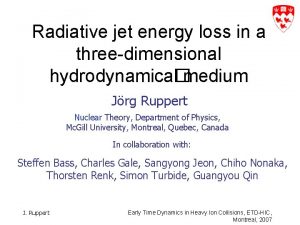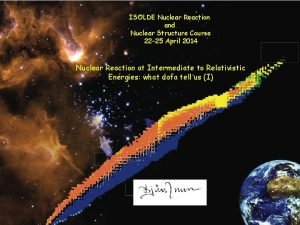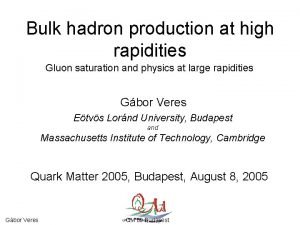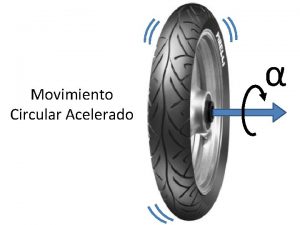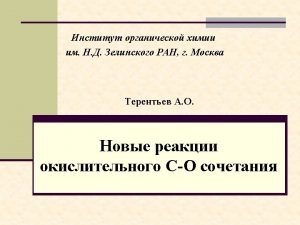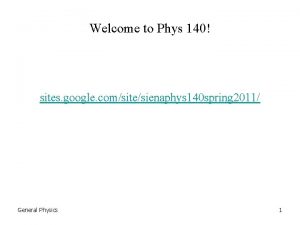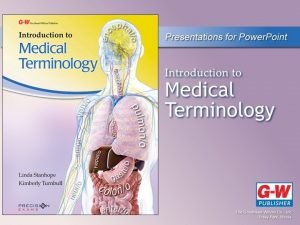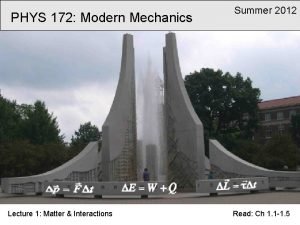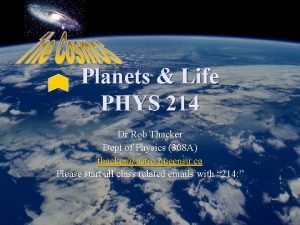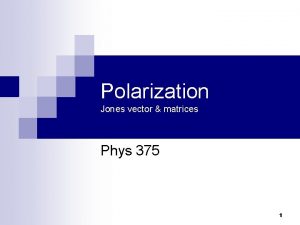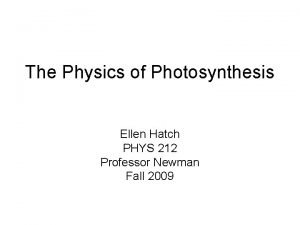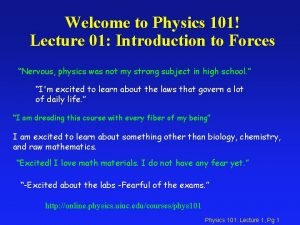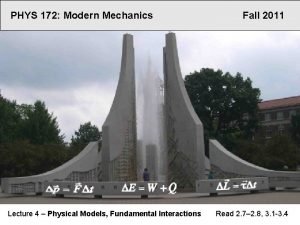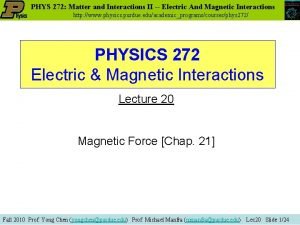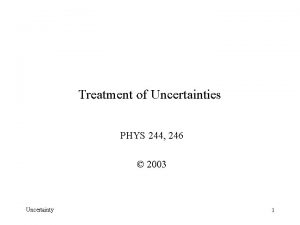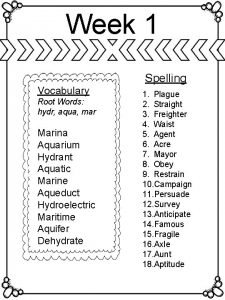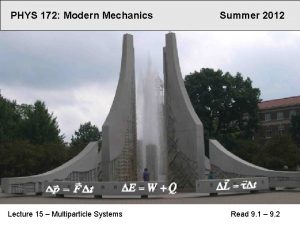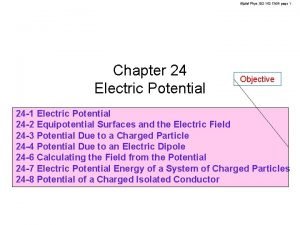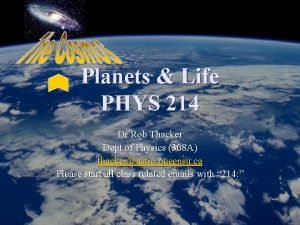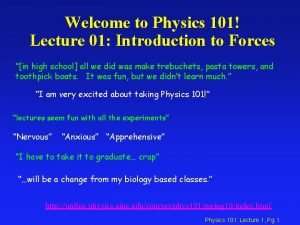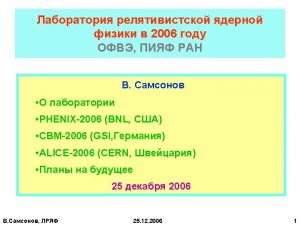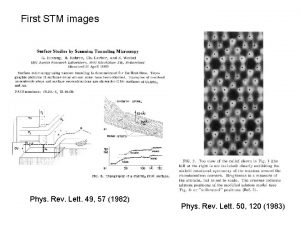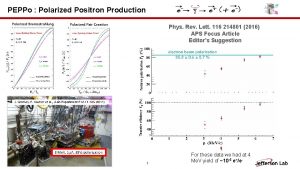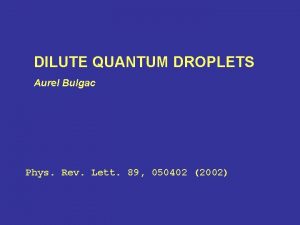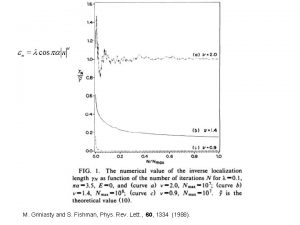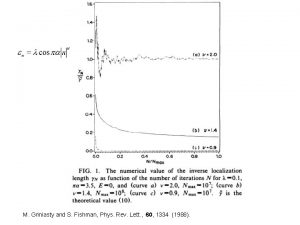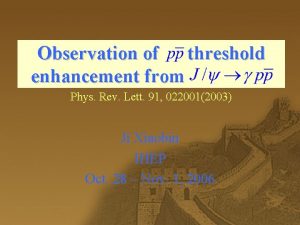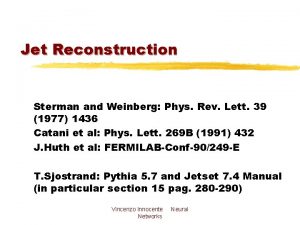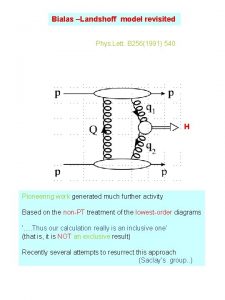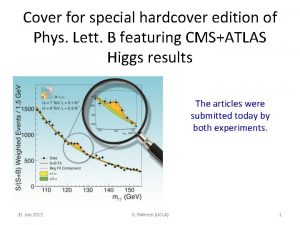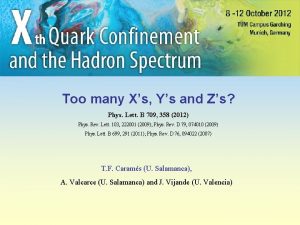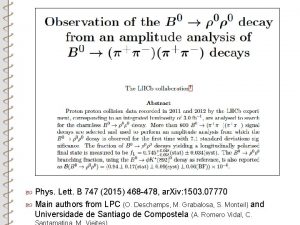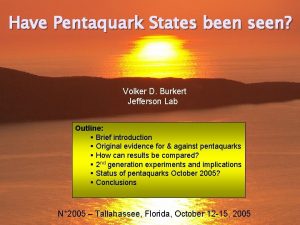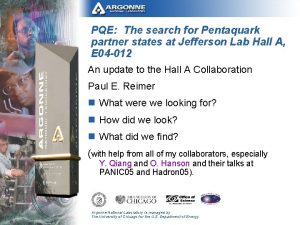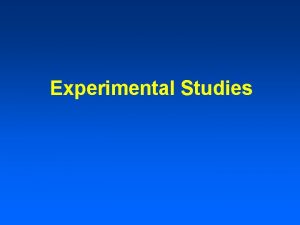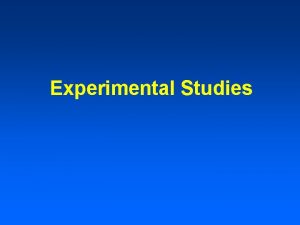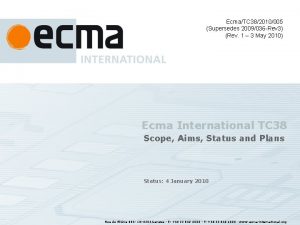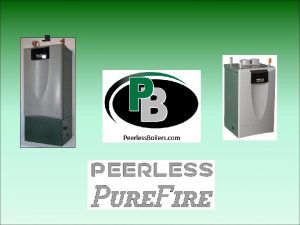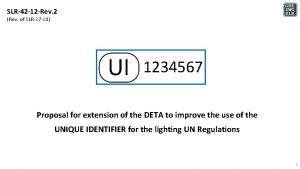Experimental Status of Pentaquark States Phys Rev Lett































- Slides: 31

Experimental Status of Pentaquark States Phys. Rev. Lett. 91 (2003) 012002 Introduction Experimental evidence Production mechanisms What do we know about the Q+? Exotic cascades states Special Thanks CLAS Collaborators SPring-8 uudds Mass = 1. 54 Ge. V Elton S. Smith / APS Meeting / Denver May 1 -4, 2004 1

Quarks are confined inside colorless hadrons Quarks combine to “neutralize” color force q q q Mystery remains: Of the many possibilities for combining quarks with color into colorless hadrons, only two configurations were found, till now… Elton S. Smith APS, Denver May 1 -4, 2004 2

What are pentaquarks? § Minimum quark content is 4 quarks and 1 antiquark § “Exotic” pentaquarks are those where the antiquark has a different flavor than the other 4 quarks § Quantum numbers cannot be defined by 3 quarks alone. Example: uudss, non-exotic Baryon number = 1/3 + 1/3 – 1/3 = 1 Strangeness = 0 + 0 − 1 + 1 = 0 Example: uudds, exotic Baryon number = 1/3 + 1/3 – 1/3 = 1 Strangeness = 0 + 0 + 1 = +1 Elton S. Smith APS, Denver May 1 -4, 2004 3

Pentaquarks – two approaches Chiral soliton model: (Diakonov, Petrov, Polyakov) Pentaquark comes out naturally from these models as they represent rotational excitations of the soliton [rigid core (q 3) surrounded by meson fields (qq)] Quark cluster models, e. g. di-quark description (Jaffe, Wilczek) (ud) s L=1 (ud) Soliton: (simplified) L=1, one unit of orbital angular momentum needed to get J=1/2+ as in c. SM Meson fields Lattice QCD => JP = 1/2 Elton S. Smith APS, Denver May 1 -4, 2004 4

The Anti-decuplet of SU(3)f Ten observations Null Results? X 5−− X 5 0 One experiment D. Diakonov, V. Petrov, hep-ph/0310212 Elton S. Smith APS, Denver May 1 -4, 2004 (revised version) 5

Experimental Evidence § Many experiments § No dedicated experiments to date ─ but, … dedicated experiments are starting to take data For new data from SPring-8 see Hicks Session J 2 Sun 10: 45 § Walk through the analysis from CLAS § Selected examples from other experiments Elton S. Smith APS, Denver May 1 -4, 2004 6

Quark lines for the reaction g us us K+ Q+ n K− ddu n Q+ is composed of (uudds) quarks Elton S. Smith APS, Denver May 1 -4, 2004 7

Production mechanisms g n p K+ n (p) K+(K 0) Q+ pspec Control Reactions K+ g g n p K− K− S− n p− pspec Elton S. Smith p n APS, Denver K+ K− L*(1520) p K− nspec May 1 -4, 2004 8

JLab accelerator CEBAF Continuous Electron Beam • Energy 0. 8 ─ 5. 7 Ge. V • 200 m. A, polarization 75% • 1499 MHz operation • Simultaneous delivery 3 halls Elton S. Smith APS, Denver May 1 -4, 2004 9

CEBAF Large Acceptance Spectrometer Torus magnet 6 superconducting coils Electromagnetic calorimeters Lead/scintillator, 1296 photomultipliers Liquid D 2 (H 2)target + g start counter; e minitorus Drift chambers argon/CO 2 gas, 35, 000 cells Gas Cherenkov counters e/p separation, 256 PMTs Time-of-flight counters plastic scintillators, 684 photomultipliers Elton S. Smith APS, Denver May 1 -4, 2004 10

gd → p K+K─ (n) in CLAS K+ K- p Elton S. Smith APS, Denver May 1 -4, 2004 11

Particle identification by time-of-flight Elton S. Smith APS, Denver May 1 -4, 2004 12

Reaction gd→p. K+K-(n) n Clear peak at neutron mass. n 15% non-p. KK events within ± 3 s of the peak. n Almost no background under the neutron peak after event selection with tight timing cut. Reconstructed Neutrons Elton S. Smith APS, Denver May 1 -4, 2004 13

Deuterium: n. K+ invariant mass distribution Q+ NQ = 43 events Mass = 1. 542 Ge. V G< 21 Me. V Significance 5. 2± 0. 6 s Two different Background shapes Distribution of L*(1520) events Elton S. Smith APS, Denver May 1 -4, 2004 14

Searching for Q+ on a proton target gp→p+K- K+ (n) Prominent K*0 no cuts K*0 M(n. K+) [Ge. V] Elton S. Smith APS, Denver May 1 -4, 2004 15

Searching for the Q+ on a proton target gp→p+K-K+(n) Eg = 3 – 5. 5 Ge. V g Cosq*(p+) > 0. 8 p− Q+ p 7. 8 s p+ n Q+ N* K− K+ M=1555± 10 Me. V G< 26 Me. V Cosq*(p+) > 0. 8 Cosq*(K+) < 0. 6 cut CLAS Collaboration PRL 92, 032001 -1 (2004). M(n. K+) [Ge. V] Elton S. Smith APS, Denver May 1 -4, 2004 16

Q+ ─ N* production mechanism? g cuts outside cuts Q+ p− p N* ? N* p+ n Q+ K− K+ § What do p-p scattering data say? M(n. K+K−) [Ge. V] Elton S. Smith § p-p cross section data in PDG have a gap in the mass range 2. 3– 2. 43 Ge. V. APS, Denver May 1 -4, 2004 17

Diffractive mechanism? g K- K*0 p+ p Q+ Require forward K 0* Cos q*(K−p+) > 0. 5 Elton S. Smith APS, Denver May 1 -4, 2004 18

Q+ NOT produced in association with K*0 events Non K*0 events Elton S. Smith APS, Denver May 1 -4, 2004 19

HERMES e+d→(p. Ks 0) X Airapetian et al. Hep-ph/0312044 27. 6 Ge. V positrons M=1528± 3. 3 Me. V G ~ 17± 9 Me. V Mass (K 0 p) [Ge. V] Elton S. Smith APS, Denver May 1 -4, 2004 20

New results from COSY-TOF hep-ex/0403011 pp → S+ K 0 p M=1530± 5 Me. V G< 18 Me. V s ~ 0. 4± 0. 1 mb 2. 95 Ge. V M(K 0 p) Ge. V/c 2 The TOF spectrometer at the COSY facility in Juelich, Germany found evidence for the Q+ in the reaction: p + p → S+ + Q+. Elton S. Smith APS, Denver May 1 -4, 2004 21

From ZEUS at DESY… ZEUS hep-ex/0403051 ep →e. Ks 0 p X M=1521. 5± 1. 5 Me. V G~ 8± 4 Me. V √s ~ 310 Ge. V Q 2 > 20 Ge. V 2 Mass (K 0 p) [Ge. V] Elton S. Smith APS, Denver May 1 -4, 2004 22

Mass (Ge. V) What do we know about this S=+1 state? LEPS : g. C→(n. K+) K−X DIANA : K+Xe→(p. K 0) X CLAS-d : gd→(n. K+) K−p CLAS-p : gp→(n. K+) p+K− SAPHIR : gp→(n. K+) K 0 ITEP : n d, Ne→(p. K 0) K 0 HERMES : e+d→(p. K 0) X COSY-TOF: pp→(p. K 0) S+ Upper limit or estimate of G (Ge. V) Elton S. Smith ZEUS : ep→e (p. K 0) X SVD-2 : p. A→(p. K 0) X ( ) Strangeness undetermined Decay products in parenthesis APS, Denver May 1 -4, 2004 23

Search for pentaquarks in HERA-B hep-ex/0403020 L*(1520) Q+ ? M(p. K 0 s) (Ge. V) M(p. K−) (Ge. V) p. A →K 0 p X Null result at HERA-B Q+(1540) √s ~ 41. 6 Ge. V L*(1520) Elton S. Smith APS, Denver < 0. 02 May 1 -4, 2004 24

There is much more to learn § Spin, parity ─ Chiral soliton model predicts Jp=½+ (p-wave) ─ Quark model naïve expectation is Jp=½− (s-wave) ─ Lattice calculations predict Jp=½− § Isospin ─ Likely I=0, since searches for p. K+ partners unsuccessful § Width (lifetime) ─ Measurements mostly limited by experimental resolution. ─ Theoretical problem remains why the state is so narrow. ─ Analysis of existing K+d scattering data indicate that G < 1 -2 Me. V. § Complete determination of the pentaquark multiplet Elton S. Smith APS, Denver May 1 -4, 2004 25

A new cousin: observation of exotic X 5−− M=1. 862± 0. 002 Ge. V ssddu X 50 Q+ X(1530) X 5−− X 50 NA 49 CERN SPS Phys. Rev. Lett. 92 (2004) 042003 Elton S. Smith APS, Denver May 1 -4, 2004 26

But, can it be reproduced? ? HERA-B hep-ex/0403020 X(1530) X− p + + X+ p − X− p − + X+ p + Mass (Ge. V/c 2) § HERA-B collaboration at DESY (Germany) § Null result with much higher statistics! § They also have a null result for the Q+ Elton S. Smith APS, Denver May 1 -4, 2004 27

Predictions depend on dynamics Decay modes are sensitive to dynamical picture Number of states and mass spectra Ss X X 5 Ns X 5 BR(X 5 → K− S−) BR(X 5 → p− X−) S N LS Q BR(X 5 → p 0 X−) BR(X 5 → p− X 0) Q N Di-quark Soliton Note: Models adjusted to experiment Elton S. Smith APS, Denver May 1 -4, 2004 28

Search for exotic cascades X 5−− and X 5− Experiment 04 -10, scheduled to run this fall X −− → p− X− L → p− p X − → p− L Electron beam gn→K+K+X 5−− Two decay vertices, Negatives bend outwards Elton S. Smith APS, Denver May 1 -4, 2004 X− ct = 4. 9 cm L ct = 7. 9 cm <gb> ~ 1. 5 29

Current activities at Jlab § Pentaquark experiments in Hall B ─ g 10 (currently taking data) gd → Q+ Eg~1 – 3. 5 Ge. V ─ g 11 (starts in mid-May) gp → Q+ Eg~1 – 3. 5 Ge. V ─ eg 3 (November) gvd→ X 5−−, X 5− Eg> 3. 9 Ge. V ─ High energy data gp → Q+, X 5 Eg~1. 5 – 5. 4 Ge. V § Pentaquark experiment in Hall A ─ E 04 -012 (May), search for excited Q++ and Q 0 states. Elton S. Smith APS, Denver May 1 -4, 2004 30

Summary § A key question in non-perturbative QCD is the structure of hadrons. § We have reviewed the evidence for the existence of a new class of colorless hadrons with quantum numbers which cannot be generated from solely three quarks: ─ There is substantial corroborating evidence for an exotic baryon with S = +1, which would have a minimal quark content of (uudds). ─ The observation of a doubly negative S=− 2 baryon (ddssu) is consistent with a second corner of the anti-decuplet the family of pentaquarks, but needs additional confirmation. § Dedicated experiments are being mounted which should easily establish (or refute) the observations to date. Elton S. Smith APS, Denver May 1 -4, 2004 31
 Chiho nonaka
Chiho nonaka Phys. rev. c
Phys. rev. c Phys. rev. c
Phys. rev. c Formula velocidad tangencial
Formula velocidad tangencial Kim lett
Kim lett Business letter vs friendly letter
Business letter vs friendly letter Lett advokatfirma
Lett advokatfirma Experimental vs non experimental
Experimental vs non experimental Nonexperimental study
Nonexperimental study Research approaches and designs
Research approaches and designs Disadvantages of experimental research
Disadvantages of experimental research Experimental vs nonexperimental research
Experimental vs nonexperimental research Tyranny
Tyranny What were the 11 free states
What were the 11 free states Southern states vs northern states
Southern states vs northern states Phys 140
Phys 140 Att phys medical abbreviation
Att phys medical abbreviation Phys 172
Phys 172 Tsms phys ed
Tsms phys ed Subtle
Subtle Half wave plate matrix
Half wave plate matrix Phys 212 equation sheet
Phys 212 equation sheet Taekjip
Taekjip Iterative prediction of motion
Iterative prediction of motion Purdue phys 272
Purdue phys 272 Phys 244
Phys 244 Hydr root
Hydr root Phys 172
Phys 172 Physics 241
Physics 241 Aljalal phys 102
Aljalal phys 102 Phys 214
Phys 214 Phys 101 uiuc
Phys 101 uiuc
